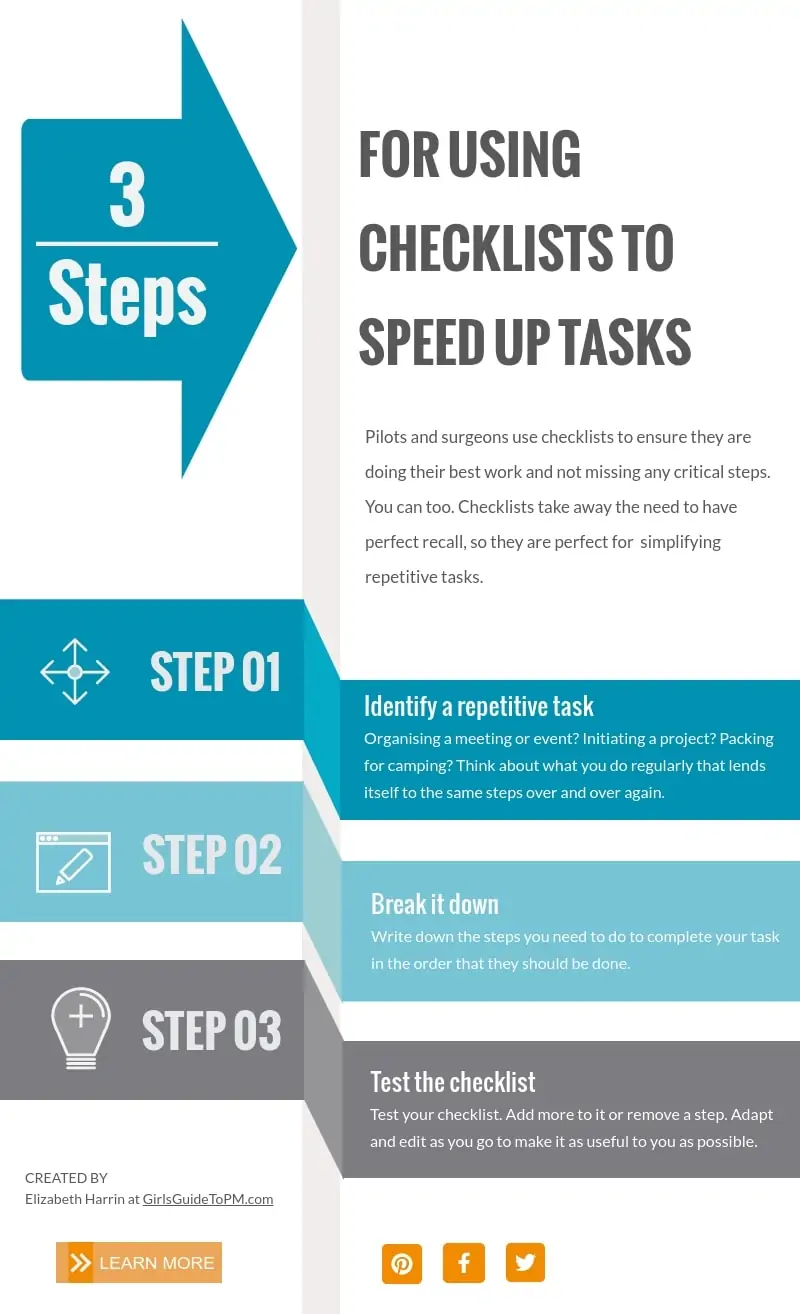How to Create A Checklist to Speed Up Tasks in 3 Easy Steps
This blog is reader-supported. When you purchase something through an affiliate link on this site, I may earn some coffee money. Thanks! Learn more.
Before I had children I traveled a lot. My job took me all round Europe. My husband traveled for work as well, and we’d often meet in odd places just to guarantee seeing each other – Majorca, Malta, Antigua. I enjoyed it, but I didn’t like the stress of packing at short notice because my boss wanted me in Barcelona tomorrow.
With such a busy schedule, it was an extra burden to dredge up from memory what I needed to take. I needed to be able to pack on auto-pilot. I needed to stop having to remember.
So I stopped.
In this article, I’ll share how I did that, using checklists, and how you can use my simple 3-step process to streamline and simplify pretty much any work (or personal) task you do regularly.
Checklists save you time because they do the thinking for you
On 30 October 1935, the new Boeing 299 had a test flight in Dayton, Ohio. It was bigger and faster than any other plane the US Army had seen and they had already planned to order some. It was piloted by the US Army’s Chief of Flight Testing, an experienced pilot, and yet it crashed.
Two of the five crew lost their lives but there was nothing wrong with the plane. The investigation concluded it was “pilot error” and the plane was simply too complex to fly.
That’s when a group of test pilots decided they needed a checklist.
With the checklist, the plane wasn’t too complex to fly. Pilots could use their brainpower on the work they really needed to do, and everything else was simply following a process.
Use checklists to simplify repetitive tasks
Checklists take away the need to have perfect recall, so they are great to simplify repetitive tasks.
Pilots still use checklists in the cockpit today and while packing my suitcase is nothing like as complicated as getting a plane off the ground, the concept is the same: when you are doing something you do a lot, make it as easy as possible to do it consistently well, every time.
My test: The packing checklist
I used some of the project management skills I’ve gained over the years to put together a checklist for packing. The great thing about project management is how adaptable it is — you can use the techniques in your home life too. It’s pretty easy to create a checklist, and it doesn’t take much time. The benefits are significant too, I’ve found.
My packing checklist freed up a lot of brainpower. It was a relief to not have to fight my memory to remember what needed to go in the case.
Since I’ve had two boys I don’t travel as much for work anymore. But I’ve added another checklist to my iPad: a packing list for the babies (which I’ve adapted as they’ve got older) as when you are sleep deprived you really can’t rely on memory to make sure that you’ve got everything you need for a weekend at Grandma’s.
The checklists covers items for adults and children, and lists things to take as well as things to do before leaving home.
I know it seems really easy and basic, but I didn’t have this before and now I do, well, I wouldn’t go back to the old way (i.e. using my memory).
So how do you create your own checklists? It’s really easy. Read on for the 3 steps you need to know.

3 Steps to create a checklist
It’s really very easy to take the stress out of tasks you do often. Here’s how to create your own checklists.
Step 1: Decide on the checklist topic
Find something you do that is repetitive (you don’t have to do it every week) but that requires you to remember multiple steps or items. How about:
- Reviewing your risk or issue log
- Preparing for a meeting (I actually already made a checklist for that)
- Gathering data for monthly reports and then writing up the reports
- The things you need to do prior to, during and after staff annual reviews for your team
- The winter chores for the garden
- Organizing an event for your club or group.
Step 2: Break the activity into tasks
Break down the activity into component tasks.
Your list can either be in the order that you should do the tasks, or as one big list (where the order of tasks doesn’t matter).
You can also split the list into sections where similar themed tasks are grouped together — this makes it easier to do them as you’ll be working on similar tasks at the same time.
I’ve found it doesn’t matter what you use to create the list. Whether it’s an app like Process St, which is specifically designed to make beautiful checklists, your project management software, or a document you print out or fill in digitally, the most important thing is that the format needs to work for you.
Personally, I favor a mixture of my PM software and documents that I either refer to on the screen or print out and keep inside my notebook.
Step 3: Test the checklist
Now you’ve created a checklist, you should test it!
This last step is important, because who’s to say that the moment you create your checklist you’re going to remember every last thing?
You can add more to your checklist as you use it. After arriving in Denmark with the wrong currency I made sure to add “travel money” to my list!
Your checklist can always be a work in progress — add things to it as you learn from the experience of using it.
Back to the plane: Checklists for stress-free task management
Let’s go back to what happened with that plane.
With the tasks written down, the Model 299 flew over 18 million miles without one accident. The plane wasn’t too complex to fly, it was just too complex to remember everything under pressure.
Even if you don’t face the pressure of an airline pilot, our work and home lives could do with a little simplification now and then to free up our brainpower for use on other things.
Personally, I’ve found that my checklists take a lot of the stress out of leaving the house, which makes it a more pleasant experience for everyone.
Checklists help me decide what’s right in each situation because obviously I’m not going to pack snowsuits for the boys in the summer, but at least I don’t have to think about what’s right for the weather anymore — I just pick the right clothing off the list.
Get project management checklists
At work, I use project management checklists as a prompt for the tasks I should be doing daily, weekly, monthly and annually.
You can grab the lists I use as part of the Project Manager’s Productivity Bundle (and you get a whole lot of other things besides).

The checklists include common tasks you should be doing as a project manager as well as space to add your own extra notes so you can personalize the lists.
I hope you find them useful!
